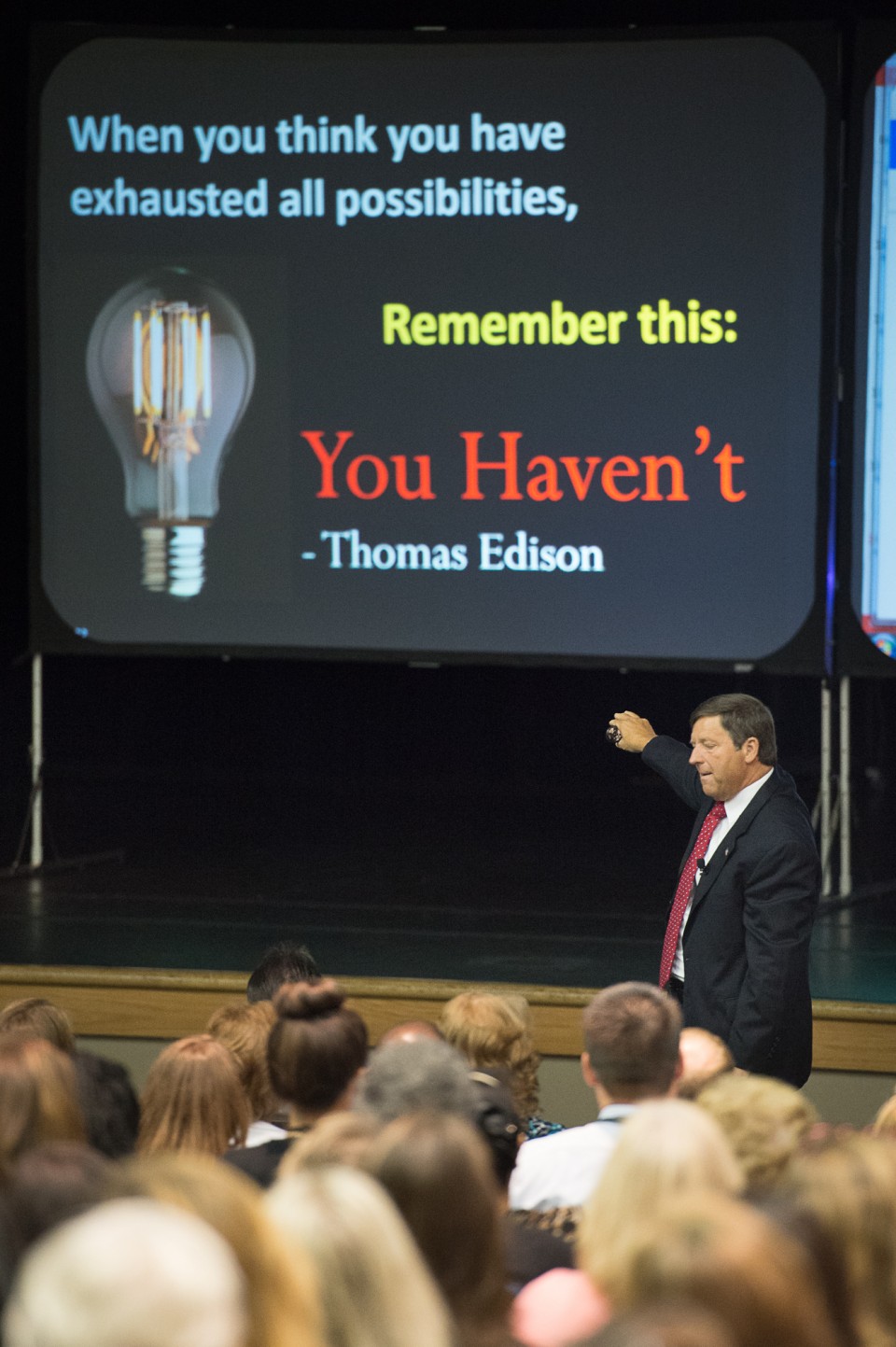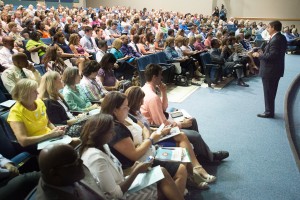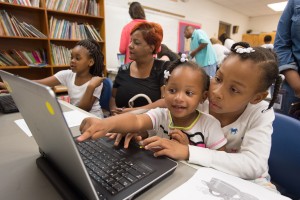Moving Escambia schools into the 21st century
- August 7, 2015
- / Reggie Dogan
- / education

Superintendent of Schools Malcolm Thomas speaks to educators during the Escambia County School District 2015 Administrators Conference at Booker T. Washington High School Friday, July 31, 2015. (Michael Spooneybarger/ Studer Community Institute)
President Barack Obama last year called on local school officials to help meet his goal of bringing high-speed Internet to every American student within a few years to compete with counterparts in countries who already use technology to help them learn.
Escambia County schools are already are wired for high-speed Internet, with WiFi connections in all classrooms.
This fall every third- and 12-grader at West Pensacola and C.A. Weis elementary schools, and Bellview and Woodham middle schools, will get their own Chromebook.
Nearly half of third- to 12-graders in Escambia County schools will have access to a laptops this school year.
By 2018, every student in every school will have one.
“We can wait for the future or we can start right now to lead and prepare for the future, not for us but for our kids,” Escambia School Superintendent Malcolm Thomas said. “The world around us is changing at a rapid pace … but we’re not going to wait for somebody to tell us what the answer is. I’m not looking for a new program, because we know the answers.”
Thomas gave some of the answers to improve education in Escambia County when he presented his “Vision 2020 Making a Difference For the Future” at Booker T. Washington High School.
Hundreds of district administrators, principals, teacher-leaders and specialists , using laptops, and smartphones, took note of Thomas’ wide-ranging plans to evolve and involve schools in 21st century technology.

Superintendent of Schools Malcolm Thomas speaks to educators during the Escambia County School District 2015 Administrators Conference at Booker T. Washington High School. (Michael Spooneybarger/ Studer Community Institute)
Despite huge advances in classroom technology and the science of learning, U.S. schools remain a relic of another era.
Emerging technologies and globalization have resulted in political, social and cultural changes. These changes have a profound impact on all aspects of human life, including education.
Yet while society has changed and continues to change, schools are slow to keep up.
Global Learning Academy Principal Judy LaBounty said, while her school has been moving in the right direction technologically, it’s time to bring all classrooms into the 21st century.
“(Thomas) has opened the door for us to allow students to be who they are and to express themselves, and we need to capitalize on the talents and gifts that they have,” LaBounty said.
“We’ll looking forward to an exciting school year and I really think it’s going to be awesome.”
For too long schools have focused heavily on testing, followed by homework, projects and class participation, Thomas said
Escambia schools this fall will start to reverse the model and make class participation the focus, using Maker Spaces and Genius time, and fewer assessments.
“We’ll still have accountability, but we want to knock testing off the throne and put learning back on top,” Thomas said.
The theme of Vision 2020 is engagement, with teachers and students using technology and to create to classrooms that use tools and technology to enhance learning and increase student achievement.
The key concepts of Vision 2020 include:
- — Transforming the school culture.
- — Seeking professional development and growth.
- — Providing student-centered tools and technology.
- — Connecting the arts with academics.
- — Changing Media Centers into Innovative Centers.
“A lot of people talk about reforming education,” Thomas said. "We don’t need to reform, we need to transform … The magic is not in the place, but in the people.”
The far-reaching technological plan of having laptops in every student’s hands by 2018 will cost the district about $3 million. Some schools have discretionary funds to use, but mostly the laptops will be paid for with Race to the Top and Title I funds, Digital Classrooms categorical and local taxes.
Too often lessons taught in high schools often skimp on 21st century skills such as collaboration and real-world problem solving, according a recently released report by Gallup.
The research organization worked in conjunction with Microsoft Partners in Learning and the Pearson Foundation to interview 1,014 people ages 18-35 with varying levels of education, asking them to recall their last year of school.
Only 22 percent of students with a high school education or less say teachers prompted them to apply what they learned to a real-world problem, according to the report.
Through Genius time, Thomas wants to see students who complete their assignments working on projects alone or in groups, using innovation to create new things and solve old problems.
In the new classroom model, Maker Spaces will give students a place to go use their head and hands for innovation and inventions, to work on and develop projects, and to discover new possibilities in learning and education.

Students work together during family literacy night at Lincoln Park Primary School in Pensacola. (Michael Spooneybarger/ Pensacola Today)
In the 21st century classroom, students can use technology to see what is dominating the news cycle and think about how it applies to their lessons.
Teachers, for example, can use severe weather outbreaks and environmental disasters to illustrate everything from climate patterns to the logistics of coordinating relief efforts.
Instead of teachers creating lesson plans alone, students will play a role in deciding what they learn, Thomas said.
“We want to create a school district where parents want to send their children, where students want to go to learn, where teachers want to teach and employees want to work,” Thomas said.
Washington High School principal Michael Roberts said the Vision 2020’s “back-to-school rally” encourages principals and teachers to use different ways to use technology to improve teaching, engage students and expand creativity.
Roberts especially embraced the idea of putting Chromebooks into every student’s hands. Washington High was one of the first schools to use BYOD, or Bring Your Own Device to school, four years ago.
Thomas’ directive to change media centers into innovative centers was deja vu for Roberts.
Five months ago his media specialist presented a six-page report to transform the school’s center, and that many of her suggestions were echoed by Thomas in his Vision 2020 message.
“What we’re getting ready to see happen across the district are things we’re already doing,” Roberts said. “There’s a lot to be done, and we have a lot of work to do and we need to do it with a sense of urgency so that our students in Escambia County will not be left behind.”
 CivicCon launches with a look at good growth in cities
CivicCon launches with a look at good growth in cities
 Building stronger brains one baby, one parent at a time
Building stronger brains one baby, one parent at a time
 SCI debuts commercial on Early Learning City
SCI debuts commercial on Early Learning City
 Entrecon: World class speakers and an opportunity to sharpen skills
Entrecon: World class speakers and an opportunity to sharpen skills
 PYP Quality of Life survey 2017
PYP Quality of Life survey 2017
 EntreCon Pensacola 2016: A look back
EntreCon Pensacola 2016: A look back
 Leadership tip: getting better employee takeaways
Leadership tip: getting better employee takeaways
 Leadership tip: be interested instead of interesting
Leadership tip: be interested instead of interesting
 Leadership tip: delivering difficult messages
Leadership tip: delivering difficult messages
 Brain Bags boost Arc, Early Childhood Court programs
Brain Bags boost Arc, Early Childhood Court programs